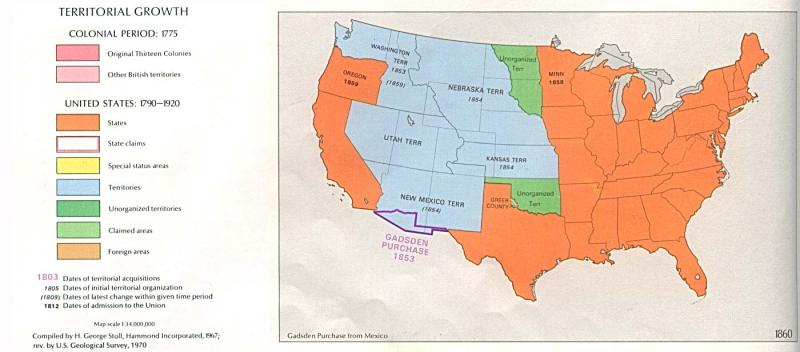U.S. territorial growth, 1860
This map shows which areas of the United States were official territories, states, and unorganized territories as of 1860, as well as which years they were organized.
Westward expansion increased tensions between those who supported and opposed slavery, especially the admission of Kansas and Nebraska as U.S. territories.
While the Nebraska Territory was too far north for slavery to be profitable, thus slavery was never in serious contention there, whether or not Kansas would be a free or slave state was a source of major conflict. Kansas lay north of the Missouri Compromise line -- the southern border of Missouri -- and should therefore have been a free state according to the 1820 legislation. But the Kansas-Nebraska Act (May 1854) gave residents the option of forming a slave state. The decision to let the Kansas and Nebraska territories decide the slavery issue for themselves enraged northern Free-Soilers, who saw it as a foothold for the expansion of slavery throughout the nation, and a war -- "Bleeding Kansas" -- broke out in the territory.
Click here for a larger version of the image.

Stoll, H. George. [Territorial Growth 1860], 1967, map, https://commons.wikimedia.org/wiki/File:USA_Territorial_Growth_1860.jpg.
Public Domain
Public Domain is a copyright term that is often used when talking about copyright for creative works. Under U.S. copyright law, individual items that are in the public domain are items that are no longer protected by copyright law. This means that you do not need to request permission to re-use, re-publish or even change a copy of the item. Items enter the public domain under U.S. copyright law for a number of reasons: the original copyright may have expired; the item was created by the U.S. Federal Government or other governmental entity that views the things it creates as in the public domain; the work was never protected by copyright for some other reason related to how it was produced (for example, it was a speech that wasn't written down or recorded); or the work doesn't have enough originality to make it eligible for copyright protection.